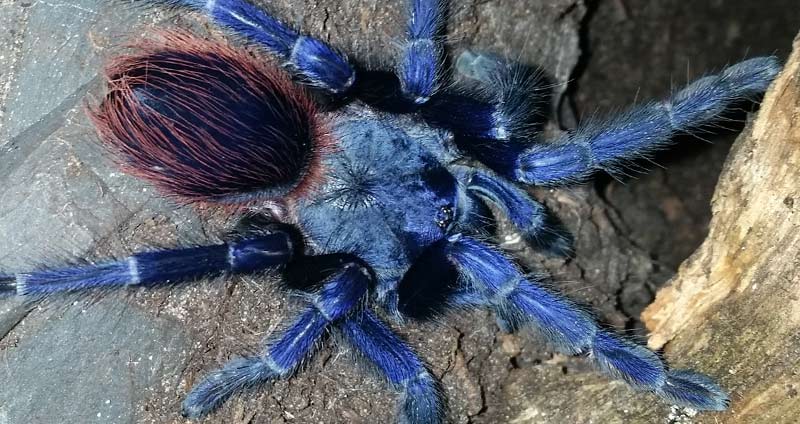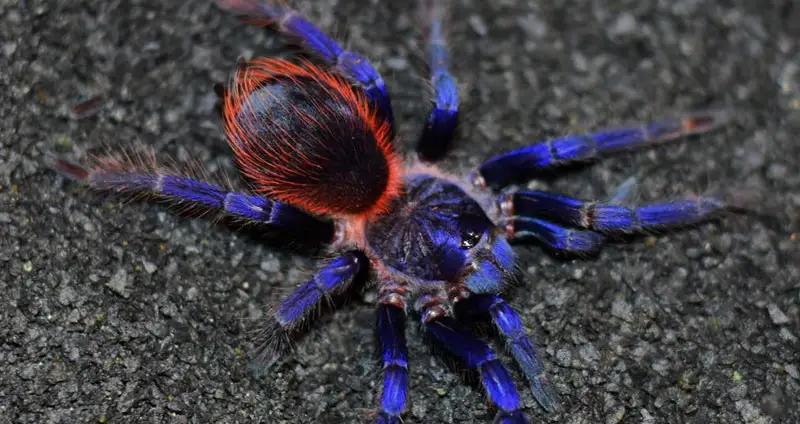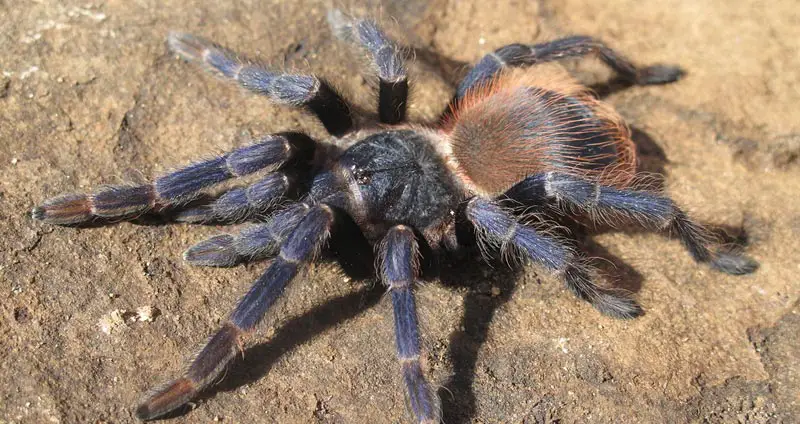There are over 800 different types of tarantulas, but it seems as if most of them that come out of South America are some of the most beautiful specimens out there.
Pterinopelma sazimai is no exception to this! This incredible tarantula has a beautiful appearance, great personality, and an exclusivity to it that makes it even more alluring.
This care sheet will tell you everything that you need to know about the Brazilian Blue Birdeater Tarantula in terms of their appearance, temperament, and how to properly care for them.
Table of Contents
Pterinopelma sazimai Care Sheet
Common Name |
Brazilian Blue Birdeater |
Species Type |
New world terrestrial |
Habitat |
Found in the highlands of eastern Brazil, which is an area with moderate temperatures and substantial rainfall year-round. |
Growth Rate |
Medium-to-fast growth rate, growing multiple inches in a year. |
Adult Size |
Females reach a legspan of around 6″, with males measuring slightly smaller. |
Lifespan |
Females can live up to 12 years, while males live for around 3 years. |
Enclosure |
The enclosure should be wider and longer than it is tall with an emphasis on floor space. Several inches of substrate need to be present for burrowing, and a hide and water dish should be supplied. |
Temp/Humidity |
75°F to 82°F with about 70% to 80% humidity. |
Diet |
Good eater that can eat several adult-sized crickets per week. Dubia roaches and mealworms should be used as supplemental food. |
Temperament |
Quite a docile tarantula. Some owners report theirs being skittish, while others say that theirs are very calm and never throw up threat poses. |
Experience Level |
Beginner – A friendly an easy to care for tarantula that’s suitable for both beginner and experienced keepers. |
Average Cost |
Slings ~ $50, Males ~ $75, Females ~ $160+ |
Pterinopelma sazimai Appearance
One of the main reasons why this tarantula is so expensive and sought-after is its stunning appearance! Females have a deep blue color all over their body, with red setae on their abdomen.
In fact, their coloration is similar to that of Chromatopelma cyaneopubescens, but they’re a much deeper and darker blue.
Males have similar coloration to females until they reach maturity, at which point they take on a more green color and their legs aren’t as blue as females. Still a stunning specimen no matter the sex, though.
These great colors are visible under normal conditions, but exposure to direct light really accentuates the blues and makes them much more vibrant. This is an effect that’s visible in tarantulas like Chilobrachys sp. Electric Blue.
As spiderlings, this species is still colorful but more muted. The Pterinopelma sazimai lifespan is around 12 years for females and only 3-4 for males, but they fortunately reach maturity quite quickly with their fast growth rate.

Pterinopelma sazimai Temperament
Another contribution to the desirability of this tarantula is its great personality that matches its stunning appearance! While it’s still not recommended that you handle this tarantula, they’re generally quite friendly, calm, and nice to be around.
They can be a bit skittish, but they’re definitely one of the least-threatening species out there.
Pterinopelma sazimai is a new world tarantula, which are tarantulas that are known for their more laid-back personalities and preference to hide from danger as opposed to fighting it.
Most owners report that their Brazilian Blue almost never acts aggressively, and won’t even flick their urticating hairs.
In fact, they’re related to Lasiodora tarantulas through a common ancestor, so there’s a decent amount of overlap in their personalities.
In terms of their day-to-day activities, this species is pretty interesting! They’re opportunistic burrowers because of the harsher conditions of their natural environment, but they still spend a good amount of time roaming around their enclosure.
Additionally, despite the fact that they’re terrestrial tarantulas, they exhibit characteristics of arboreal tarantulas by creating webs on slightly elevated bushes and structures. Not many species do this, so they’re definitely unique to observe.
Housing Pterinopelma sazimai
When planning on bringing home a Brazilian Blue tarantula, you first need to ensure that it will have a proper enclosure from the very start.
It’s best to construct an enclosure that won’t require a lot of alterations or accessing in the future so as not to disturb your tarantula too much.
Optimal Enclosure
While the enclosure of the Brazilian Blue tarantula needs to be constructed in a certain way, it isn’t difficult to do so.
First of all, this is a terrestrial tarantula that has a very strong desire to burrow. Therefore, their enclosure needs a large focus on floor space and depth of substrate for burrowing.
This species is unique in the sense that it also enjoys climbing, so there should still be some good vertical height to the enclosure and several anchor points to attach webbing to.
A fully-grown adult specimen would be very comfortable in the Exo Terra 18″ x 18″ x 12″ glass terrarium. This terrarium has great cross-ventilation, accessibility, and visibility — all things that are very important in a tarantula enclosure.
Lower-budget enclosures can also be constructed, but you must be sure that it’s large enough and is plenty breathable. Some plastic containers are big enough but don’t allow proper airflow.
Enclosure Decorations
The inside of your Pterinopelma sazimai enclosure needs to have a few different supplies that are suited for terrestrial species.
First and foremost, the bottom of the enclosure needs to be layered with about 6 inches of moisture-retaining substrate, like coconut fiber. Not only is this a great burrowing medium, but it also keeps the enclosure clean and maintains humidity levels.
On top of this substrate, you need to add a cork bark hide and a water dish.
The cork bark hide gives Pterinopelma sazimai a place to hide and feel secure, while the water dish prevents dehydration and contributes to the enclosure’s humidity.
After these essentials are added, you can get a bit creative. This includes adding sphagnum moss, fake plants, rocks, and sticks to the enclosure to truly customize it.

Enclosure Temperature/Humidity
The natural environment of Pterinopelma sazimai is quite harsh, experiencing very cold winters and very hot summers. In addition to the extreme temperatures, rainfall is substantial and keeps the region quite humid year-round.
This climate should be mimicked within the enclosure and maintained consistently.
Fortunately, the optimal temperature range for this species is between 75°F and 82°F, which is about room temperature for most people.
If the environment is colder than this, supplemental heating should be supplied in the form of either a space heater or a gentle heat lamp that doesn’t emit light.
In terms of moisture and humidity, don’t overdo things. While it’s true that Pterinopelma sazimai has evolved to board up its burrow to keep the excessive rain from flooding it, it doesn’t prefer overly damp environments.
Therefore, you should keep the enclosure at about 75% humidity by overflowing the water dish occasionally and misting the substrate as needed. One side should be more damp than the other to give your tarantula a choice.
It’s easy to monitor the temperature and humidity of the enclosure with the use of a simple thermometer and hygrometer.
Diet
Their diet is one unremarkable thing about Pterinopelma sazimai. It’s definitely a good eater, but not necessarily ravenous like some other species.
As tiny spiderlings, they eat flightless fruit flies until they reach about 1/2″, at which point they can eat pinhead crickets.
As adults, this tarantula can eat about 5 adult crickets per week or about 2 dubia roaches per week. This can be supplemented with the occasional mealworm or a pinky mouse every other month as a treat.
It’s nearly impossible to overfeed a tarantula, so don’t worry too much about that. However, you will want to remove any uneaten/partially eaten food from the enclosure to prevent mold and bacteria growth.
Health Concerns
In terms of healthcare, this tarantula doesn’t have anything special about it. Captive tarantulas typically don’t experience many health problems as long as their enclosures are optimal and their diets are complete.
It is possible that a captive tarantula could experience dehydration or parasites/mites, but these are uncommon occurrences that are easy to avoid.
One specific point for Pterinopelma sazimai is that it needs to be able to burrow. It naturally has the desire to burrow, so if it can’t, it may experience stress.
Additionally, be careful with making its enclosure too “swampy”. The Brazilian Blue likes humid climates, but an enclosure that’s too damp poses a health hazard.
Pterinopelma sazimai For Sale & Price
If you’re planning on bringing home this tarantula, you should expect to pay quite a bit for it. Its rarity has made it one of the most expensive tarantulas in existence today, and for a good reason.
Pterinopelma sazimai has been illegally smuggled to America and Europe, all while its natural habitat is consistently shrinking. This has made them quite rare, and they should only be purchased from a reputable breeder.
Unfortunately, this means that there’s a premium on these tarantulas.
You can purchase a sling from several online marketplaces for about $50, an adult male for around $75, and adult females for $160+. Considering most tarantulas barely cost $100, this is decently expensive for the hobby.
However, if you’re willing to fork over a bit more money, this is an incredible tarantula that’s so appealing to look at and will provide you with plenty of entertainment as it goes about its daily life.

